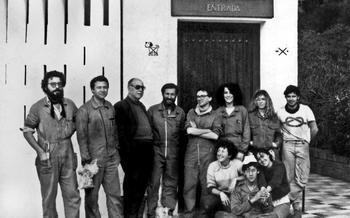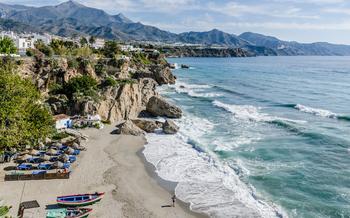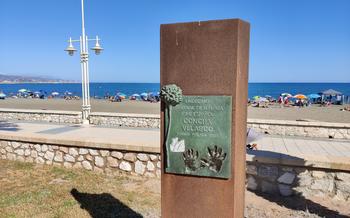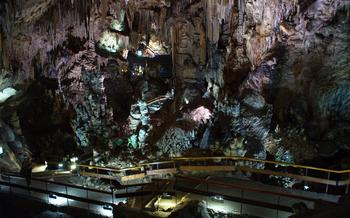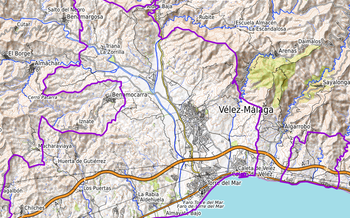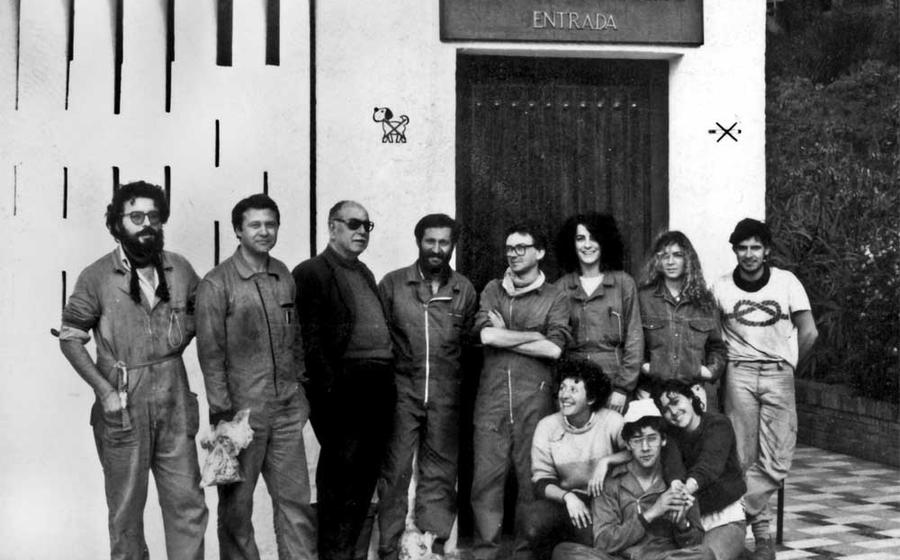
Cueva de Nerja (Nerja)
- Nerja Caves: An Enchanting Underground Realm
- Unveiling the History of the Caves
- Navigating the Cave's Interior
- Deciphering the Cave Paintings
- The Hall of Ghosts: A Sensory Experience
- Exploring the Cave's Natural Wonders
- Educational Programs and Workshops
- Accessibility and Facilities
- Special Events and Exhibitions
- Suggested Itineraries and Duration
- Photography and Videography Guidelines
- Conservation and Sustainability
- Nearby Attractions and Activities
- Practical Tips for Visitors
- Insider Tip: Hidden Treasures and Secret Spots
Nerja Caves: An Enchanting Underground Realm
Nerja Caves, discovered by a group of local boys in 1959, are an exquisite subterranean wonder, revealing a captivating world of natural formations, ancient art, and historical significance. Nestled in the hills of Nerja, in southern Spain's Andalusia region, these caves offer a unique journey into the Earth's hidden depths, promising an awe-inspiring and unforgettable experience.
The caves' geological formations are a sight to behold. Over millions of years, water has carved intricate stalactites and stalagmites that adorn the cave walls and ceilings, creating a mesmerizing display of natural art. These impressive formations, illuminated by soft lighting, cast dramatic shadows and create an ethereal ambiance, evoking a sense of wonder and admiration.
Beyond their geological marvels, the Nerja Caves are renowned for their archaeological treasures. Within the cave chambers, visitors can marvel at ancient cave paintings, a testament to the artistic expressions of prehistoric humans. These paintings, created using natural pigments and intricate techniques, depict scenes of hunting, animals, and abstract symbols, offering a glimpse into the lives and beliefs of our ancestors.
Unveiling the History of the Caves
The Cueva de Nerja has a rich history dating back thousands of years, revealing evidence of human presence from the Paleolithic era to the present day. Archaeological discoveries have unearthed tools, pottery fragments, and other artifacts left behind by Neanderthals and Cro-Magnon settlers who inhabited the caves during prehistoric times.
The most remarkable aspect of the caves' history lies in the impressive collection of cave paintings and engravings that adorn its walls. These ancient artworks, created by prehistoric humans using natural pigments and techniques, offer a glimpse into the cultural and artistic expressions of our ancestors. The paintings depict various animals, humans, and abstract symbols, providing valuable insights into their beliefs, rituals, and daily life.
Ongoing research and studies continue to unravel the mysteries of the Cueva de Nerja. Archaeologists, anthropologists, and historians collaborate to interpret the cave paintings, understand the significance of the artifacts, and piece together the intricate puzzle of human history within these underground chambers.
Navigating the Cave's Interior
The Cueva de Nerja is a vast and intricate cave system, stretching over several kilometers. To fully appreciate its wonders, visitors embark on guided tours that lead them through the different chambers and galleries. The caves are naturally divided into three levels, each with its unique characteristics.
The upper level, known as the Tourist Gallery, is the most accessible and popular section of the caves. It features a well-lit path that winds through a series of chambers adorned with impressive stalactites and stalagmites. Visitors can marvel at the intricate formations, which have been shaped by water dripping through the limestone rock over thousands of years.
Descending to the lower levels, visitors encounter the New Galleries, discovered in the 1960s. This section is known for its spectacular cave paintings, which are some of the best-preserved examples of prehistoric art in the world. The paintings depict various animals, human figures, and abstract symbols, offering a glimpse into the lives and beliefs of our ancestors.
The deepest level of the caves, known as the Third Galleries, is reserved for experienced cavers and requires special equipment and permits to access. This section features narrow passages, underground rivers, and unique geological formations that provide a thrilling and challenging adventure for those seeking an unforgettable caving experience.
Deciphering the Cave Paintings
The Cueva de Nerja is a treasure trove of prehistoric art, adorned with breathtaking cave paintings that offer a glimpse into the minds and lives of our ancestors. These artistic expressions, created with ochre, charcoal, and other natural pigments, showcase a diverse range of subjects, from animals and human figures to abstract symbols.
One of the most striking features of these paintings is their symbolism, which has been the subject of much study and interpretation. Animals like horses, deer, and goats are frequently depicted, possibly representing important cultural or spiritual figures. Human figures, often engaged in hunting or dancing scenes, provide insights into prehistoric society and daily life.
The techniques used to create these artworks are equally fascinating. The artists employed a variety of methods, including finger painting, brushwork, and engraving. They skillfully exploited the natural contours of the cave walls to create depth and movement in their compositions.
Ongoing studies of the paintings continue to shed light on their significance. Researchers analyze the pigments, styles, and motifs to gain a deeper understanding of the artistic traditions and cultural beliefs of the prehistoric inhabitants of the caves. These paintings serve as a valuable window into the past, connecting us to the lives and imaginations of our distant ancestors.
The Hall of Ghosts: A Sensory Experience
Immerse yourself in the enchanting acoustics and natural wonders of the Hall of Ghosts, a mesmerizing chamber within the Nerja Caves. Legends and folklore whisper of eerie apparitions and ghostly figures that haunt this space, creating an aura of mystery and intrigue.
The unique geological formations and natural acoustics of the hall produce a symphony of sounds that reverberate through the cavern, creating an ethereal and otherworldly atmosphere. Visitors can experience the thrill of hearing their voices echo and bounce off the walls, creating a surreal auditory illusion.
Visual wonders abound in the Hall of Ghosts, with intricate rock formations and mineral deposits that shimmer and sparkle under the cave's lighting. The interplay of light and shadow creates optical illusions and mesmerizing patterns, adding to the mystical ambiance of this subterranean chamber.
Conservation efforts have been implemented to protect this fragile and unique environment, ensuring that future generations can continue to marvel at the Hall of Ghosts. Visitors are encouraged to respect the sanctity of this natural wonder and contribute to its preservation by following guidelines and regulations.
Exploring the Cave's Natural Wonders
Beyond the artistic and historical significance of the Nerja Caves, they also showcase a remarkable array of natural wonders. The caves' diverse geological formations, unique rock formations, and mineral deposits create a captivating subterranean landscape. Visitors can marvel at the intricate stalactites and stalagmites that adorn the cave walls and ceilings, formed by the slow and continuous dripping of water over thousands of years.
The caves also feature underground rivers and water features, adding to their natural beauty and mystery. These subterranean waterways have played a crucial role in shaping the cave's formations and providing a habitat for diverse aquatic life. The caves' ecological significance is further enhanced by the presence of unique flora and fauna adapted to the unique conditions of the underground environment.
Educational Programs and Workshops
The Cueva de Nerja is not just a place of wonder and beauty; it is also an educational hub that offers visitors a range of interactive learning experiences. Interactive workshops on cave exploration, archaeology, and art bring the history and significance of the caves to life. Visitors can delve into the techniques used by prehistoric humans to create their stunning cave paintings, learn about the geological processes that shaped the caves, and even get hands-on experience with archaeological excavations. Educational programs tailored for students and families make the caves an ideal destination for educational outings, fostering a deeper appreciation for history, science, and art. These programs not only enhance the visitor experience but also contribute to the preservation and promotion of the caves' cultural heritage.
Accessibility and Facilities
Navigating the Cueva de Nerja is made accessible for visitors of all abilities, ensuring an inclusive and enjoyable experience. Guided tours are available in multiple languages, catering to a diverse range of visitors. Additionally, ramps, handrails, and accessible pathways allow individuals with disabilities to explore the caves' wonders. A well-equipped visitor center serves as a starting point, providing informative exhibits, a ticketing counter, and amenities like restrooms. Advance booking is recommended, especially during peak tourist season, to secure your preferred tour time.
Special Events and Exhibitions
The Cueva de Nerja is not just a place for exploration and learning but also a venue for cultural events and exhibitions. Throughout the year, the caves host a variety of special events and exhibitions that provide unique and immersive experiences for visitors.
Temporary exhibitions are often organized to showcase cave-related artifacts, archaeological discoveries, and artistic interpretations. These exhibitions offer a deeper dive into the history, culture, and significance of the caves. Visitors can explore displays of ancient tools, pottery, jewelry, and other artifacts found within the caves, providing a glimpse into the lives of prehistoric inhabitants.
Cultural events, concerts, and festivals are also held within the caves, creating a magical and unforgettable atmosphere. Imagine attending a classical music concert surrounded by the awe-inspiring stalactites and stalagmites. Or experience the thrill of a flamenco performance echoing through the vast chambers of the cave. These events transform the Cueva de Nerja into a vibrant cultural hub, allowing visitors to connect with the region's rich heritage and artistic traditions.
Night tours and special access opportunities offer unique perspectives on the caves. With limited lighting and smaller groups, visitors can experience the caves in a more intimate and immersive setting. Guided tours led by experienced speleologists provide in-depth insights into the cave's geology, history, and conservation efforts. Advance booking is recommended for these special events and tours to secure your spot and avoid disappointment.
Suggested Itineraries and Duration
Suggested Itineraries and Duration
A comprehensive visit to the Nerja Caves typically lasts around 45 minutes to an hour. However, you can allocate more time to explore the caves at a leisurely pace and delve deeper into their history and significance.
For a half-day trip, combine your visit to the caves with other attractions in Nerja, such as the Balcón de Europa viewpoint, the Nerja Museum, or a stroll along the scenic coastal promenade.
If you're an avid explorer, consider extending your stay in Nerja to experience the caves' hidden treasures and secret spots. With a local guide, you can venture into less-visited sections of the caves, discovering hidden chambers and unique perspectives.
Remember to plan your visit during the off-season or on weekdays to avoid the crowds and fully immerse yourself in the enchanting atmosphere of the Nerja Caves.
Photography and Videography Guidelines
Preserving the Past, Capturing the Moment
To ensure the preservation of the Nerja Caves and the enjoyment of future generations, visitors are kindly requested to adhere to the following photography and videography guidelines:
-
Designated Areas: Photography and videography are permitted only in designated areas within the caves. These areas are marked with signs to guide visitors.
-
Respect for the Environment: Flash photography and the use of tripods are strictly prohibited to minimize disturbance to the cave environment and protect the delicate rock formations.
-
Capturing the Essence: Natural light provides the most authentic representation of the caves' beauty. Visitors are encouraged to embrace the ambiance of the caves without the use of artificial lighting.
-
Respecting Privacy: Out of respect for other visitors, photography and videography should not intrude on their personal space or disrupt their experience.
By following these guidelines, visitors can contribute to the preservation of this remarkable heritage while capturing their own unforgettable memories of the Nerja Caves.
Conservation and Sustainability
Preserving the Cueva de Nerja's delicate ecosystem and cultural heritage is of utmost importance. Sustainable tourism practices are strictly enforced to minimize the impact on the caves. Visitors are required to adhere to designated pathways and refrain from touching or disturbing any formations. Photography and videography are permitted only in designated areas to prevent damage from excessive lighting.
Ongoing research and monitoring are conducted to assess the caves' health and ensure their long-term preservation. Scientists study the geological formations, cave paintings, and biodiversity to understand the caves' complex ecosystem. This knowledge guides conservation efforts and helps mitigate potential threats.
Balancing tourism with environmental protection is a delicate task. Limiting the number of visitors and implementing strict regulations helps protect the caves while allowing people to experience their wonders. The Cueva de Nerja serves as an exemplary model of how responsible tourism and conservation can coexist, ensuring that future generations can continue to marvel at this subterranean treasure.
Nearby Attractions and Activities
The Nerja Caves are just one of many attractions that the region has to offer. The town of Nerja itself is a charming whitewashed village with a beautiful beach and a lively atmosphere. Visitors can also explore the nearby towns of Frigiliana and Maro, which are both known for their stunning views and traditional Spanish architecture.
For those who love the outdoors, there are plenty of hiking trails and natural parks in the surrounding area. The Sierra Nevada National Park is a particularly popular destination, offering breathtaking mountain scenery and a variety of hiking routes.
Culture enthusiasts will also find plenty to keep them entertained in the Nerja region. The town is home to several museums, including the Nerja Museum, which houses a collection of artifacts from the caves, and the Frigiliana Museum, which focuses on the history and culture of the town.
To make the most of your visit to the Nerja region, consider planning a comprehensive itinerary that includes a visit to the caves, as well as other nearby attractions. This will allow you to experience the full range of what the region has to offer.
Practical Tips for Visitors
For an enjoyable and hassle-free visit to the Nerja Caves, consider the following practical tips:
-
Choose the right time to visit: Avoid peak tourist season (July and August) and weekends to escape the crowds. Opt for a weekday visit during the shoulder months (May-June and September-October) for a more tranquil experience.
-
Dress appropriately: The caves can be chilly and damp, so dress in layers and wear comfortable, closed-toe shoes with good traction.
-
Bring essentials: Carry a small backpack with water, snacks, a flashlight (for backup lighting), and a camera to capture your memories.
-
Be respectful of local customs: Remember that Spain is a Catholic country, and dressing modestly is appreciated when visiting religious sites or attending cultural events.
-
Learn a few Spanish phrases: A basic understanding of Spanish can enhance your interactions with locals and help you navigate the region more smoothly.
Insider Tip: Hidden Treasures and Secret Spots
While the main chambers of the Nerja Caves offer a stunning spectacle, adventurous visitors can venture beyond the beaten paths to discover hidden treasures. Request a guided tour of the upper galleries, accessible through a narrow passage, to witness unique geological formations and lesser-known cave paintings. Explore the Sala del Cataclismo, a vast chamber with towering stalactites and stalagmites, or crawl through the narrow passages of the Sala de la Mina to discover hidden chambers and ancient inscriptions. With a bit of curiosity and a sense of exploration, you'll uncover the secrets of the Nerja Caves that most visitors miss.
